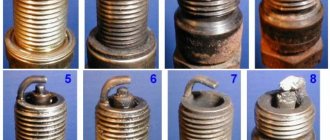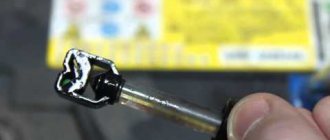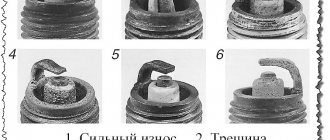The working part of the spark plug is constantly in the combustion zone of the fuel mixture and can serve as an indicator of the processes occurring inside the cylinder. Whatever plaque covers the surface of the combustion chamber, which is invisible from the outside, is deposited on the electrodes. A car enthusiast with many years of experience, accustomed to repairing a car on his own, can easily identify the problem by looking at the color of the spark plugs. This is the fastest and most convenient way to look inside the engine; you just need to disconnect the high-voltage wire and unscrew the part from the socket.
Why does carbon deposits appear on candles?
The optimal period for using spark plugs is considered to be 60,000 kilometers. Professional auto mechanics advise replacing the element immediately after crossing this milestone.
With regular care and inspection of the vehicle, it is not always possible to avoid the appearance of a light coating on the surface of the product. The normal color of the top tip is considered to be a light gray shade. The occurrence of slight changes does not affect the performance of vehicles.
- Experts identify several reasons that can provoke such changes.
- The spark plugs inside the engine are designed to act as the ignition element that creates the spark.
- It promotes combustion of the fuel mass. The design of the mechanism implies the location of these elements next to the combustion chamber of the engine.
- When the engine starts, the surface of the spark plug experiences enormous loads.
- In addition, they are exposed to increased pressure, high temperature and various physical and chemical processes.
As a result, after some time, a grayish deposit appears in the lower section of the spark plug, on the surface of the insulator or electrode. Foreign particles are evenly distributed over the surface of the metal tip.
Depending on the type of problem with the car engine, the color palette of the spark plug tip may vary. Red, orange and black spots may appear around the perimeter of the body.
Timely diagnostics will allow you to avoid serious problems in the vehicle’s performance. First of all, it is recommended to pay attention to the state of the ignition timing or ignition timing.
Downloading a book
After successfully completing the payment (by any method) and returning to the KrutilVertel store from the payment system website, you will be taken to the successful payment page:
The book you purchased will be in your personal account, from where you can always download it.
Please note that after making the payment, you need to return back from the payment system website to the KrutilVertel website. If for some reason you did not return back to the site and closed the payment system tab with a message about the successful completion of the payment, please let us know - we will send you a letter indicating access to download the book
If for some reason you did not return back to the site and closed the payment system tab with a message about the successful completion of the payment, please let us know - we will send you a letter indicating access to download the book.
Which color is not dangerous?
The performance of a gasoline engine directly depends on the condition of the spark plug electrodes. Their surface should be painted in a dirty brown shade, without traces of oil and soot elements.
If the surface of the spark plug is changed, it is recommended to carry out unscheduled technical diagnostics to detect the cause of such problems. Various parts of a gasoline engine can provoke such changes.
There are several color options that cover spark electrodes. These include:
- Grey;
- White;
- Terracotta;
- Red;
- Black.
The top of the spark plug may be covered with various deposits. Most often it is subject to oil deposits or a thick layer of soot. Such changes indicate serious problems with the engine.
Types of carbon deposits on candles
We propose to consider several situations to help understand the cause of these changes. For example, the vehicle has traveled a distance of over 25 km.
When unscrewing the spark plugs, we discovered that a light gray or terracotta tint had appeared on the surface of the electrodes.
The surface of the metal tip is undeformed and there are no traces of oil deposits. Such changes indicate the normal performance of the car. Minor changes indicate proper combustion chamber operation.
Similar shades are not always found. Many motorists, after unscrewing the spark plugs, discovered that the surface acquired the following color:
- Black;
- White;
- Red.
In addition to tint, the tip may be covered with traces of gasoline, automobile oil, ash, or corrosion. When simply inspecting spark plugs, it is important to determine the structure of the deposit.
For example, if black matte soot appears, then this phenomenon indicates contamination in the air filter area, improper fixation of the spark gap, a crack in the insulator, or improper carburetor adjustment.
The situation can be corrected by correct adjustment of engine operating processes, setting the correct spark gap, and replacing the igniting mechanism.
How to do it right
Thus, in order to get a reliable result, it is best to drive at least two hundred kilometers on obviously clean, serviceable spark plugs. In this case, the possibility of error is almost completely eliminated.
Based on the state of the spark plug, you can determine how far the car has traveled since the last replacement. Of course, the calculation is approximate; the initial data is taken to be that the distance between the electrodes of a standard spark plug increases by 0.015 mm with every thousand kilometers traveled. The service life of conventional spark plugs is usually small and amounts to 30 thousand kilometers. In stores, multi-electrode ones are offered as an alternative. They have two advantages:
- increased resource (about 60 thousand km);
- uniform propagation of the flame front in the cylinder, regardless of how the spark plug is screwed in.
Black carbon deposits on spark plugs
The occurrence of black soot is directly related to the contact of the metal tip and the air-fuel mixture. If before installation the surface was uniform or had a gray tint, then the appearance of a velvety black coating is directly related to the following reasons:
- Penetration of the oil mixture into the combustion chamber area;
- Low fuel quality;
- Multiple excesses of the permissible concentration of metal additives in gasoline;
- Malfunction of the cooling system;
- Problems with the ignition timing settings;
- Using low octane gasoline.
What to do if a dark-colored plaque appears? The first step is to familiarize yourself with the composition of the oil mixture and the condition of the piston rings. If the mixture is correctly selected, then you should pay attention to the fuel mixture.
After this, you can diagnose the cooling system and replace the spark plugs with new elements. When adjusting the ignition timing, it is recommended to pay attention to the recommendations of specialists. The fact is that an incorrect gap will provoke the occurrence of new faults.
Common mistake
To obtain a reliable result, the inspection must be carried out after the engine has been running for a long time. Otherwise, the inspection result will allow you to draw erroneous conclusions. Quite often there is a situation when drivers start a cold engine in winter and, hearing the sound of its uneven operation, turn off the spark plugs and turn them out.
Seeing black carbon deposits, they draw premature conclusions about the malfunction of the power unit, forgetting that black carbon deposits can form due to the fact that at subzero temperatures the working mixture is forcibly enriched, and due to the fact that the engine is not warmed up to the optimal temperature, it does not have time to burn completely . Unstable operation may well be explained by a malfunction of high-voltage wires that need to be replaced long ago.
White carbon deposits on spark plugs
The appearance of a white tint on the surface of the spark plug electrodes indicates a poor-quality composition of the air-fuel mixture. It is not recommended to use such gasoline in the future. The fact is that components in the fluid can cause new problems with engine operation.
When starting the engine, a disturbed combustion process is observed, which is accompanied by a large release of thermal energy. As a result, the combustion chamber overheats, thereby causing the metal tips and metal edge to melt.
Light electrodes
White or light gray spark plugs in all cylinders are a sign of a lean air-fuel mixture supplied by the injector or carburetor. Moreover, the skirt, area near the electrodes and the threaded part are absolutely dry, without traces of oil.
Why is the fuel mixture supplied lean?
- lambda - the probe incorrectly informs the control unit about the amount of oxygen in the exhaust gases, the reason is sensor wear;
- faulty or clogged nozzles;
- incorrect carburetor settings or clogged fuel jets;
- insufficient pressure in the injector fuel rail;
- problems with the idle air control;
- air leakage under the manifold or in another place;
- unsuccessful chip tuning of the controller made by the owner of the car.
A lean mixture does not pose any particular danger to a running engine, but it does cause discomfort to the driver. The car accelerates slowly, pulls poorly and jerks - there is a lack of fuel. Oddly enough, the phenomenon causes increased gasoline consumption - a car enthusiast who wants to achieve better performance indicators presses the accelerator pedal harder and more often.
Note. Often the light shade of the working electrodes is explained by the type of fuel used. If the car is operated on methane or liquefied gas (propane-butane mixture), this color is considered normal.
Red carbon deposits on spark plugs
Redness of the tips on the spark plug appears when low-quality fuel is used. Some manufacturers resort to using chemical additives made from metal components to increase the octane number.
In general, the majority of the compounds are lead. When burned, the additives begin to quickly oxidize and uniformly cover the surface of the electrical contact with an orange or red coating.
- As a result, a disturbance in the sparking process is observed. In most cases, the engine may not start the first time.
- Additives in gasoline have a negative impact on other engine components.
It is recommended to change the fuel and carry out thorough diagnostics in the power plant area. Specialized equipment will allow you to accurately detect the source of the problem and select methods to eliminate it.
Which spark plugs are best for Chevrolet Lacetti 1.4/1.6
I do not advertise and do not force anyone to follow in my footsteps. I’ll just express my opinion about the best spark plugs for the Chevrolet Lacetti from my point of view and experience in using different spark plugs.
I chose DENSO K20TT
I won’t describe all the beautiful marketing inscriptions on the box, since they are the same on all boxes from different manufacturers and boil down to one thing - You have the best candles in your hands and it couldn’t be better
A set of such candles costs up to 300 UAH. (12 USD)
Here is the candle itself out of the box
Its main feature is the thin central and special side electrodes.
They also have a built-in 5 kOhm resistance
During the entire period of operation, not a single candle, thank God, failed.











